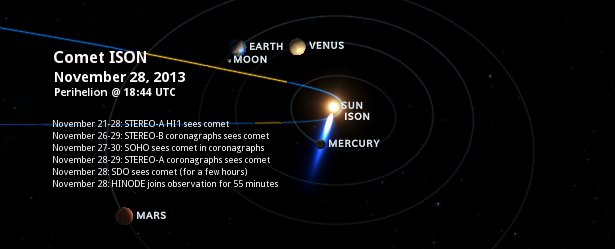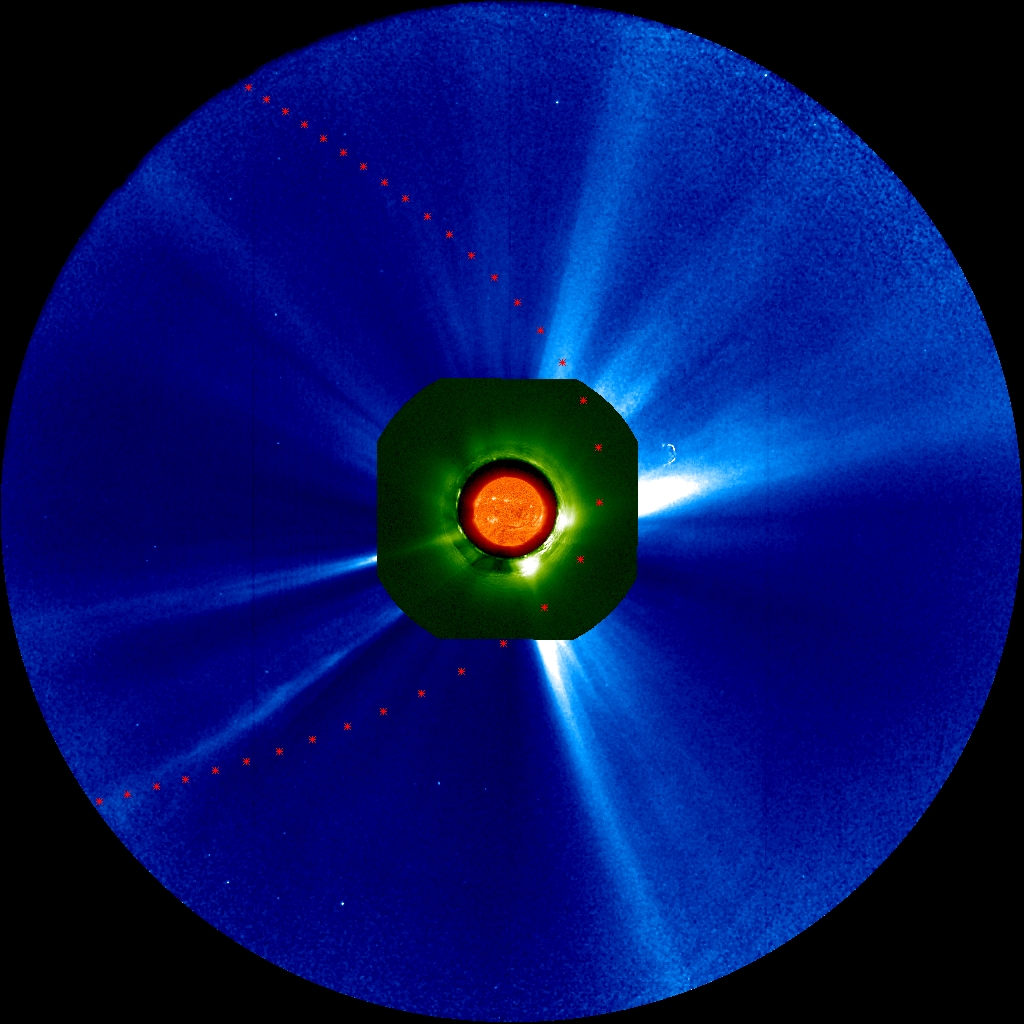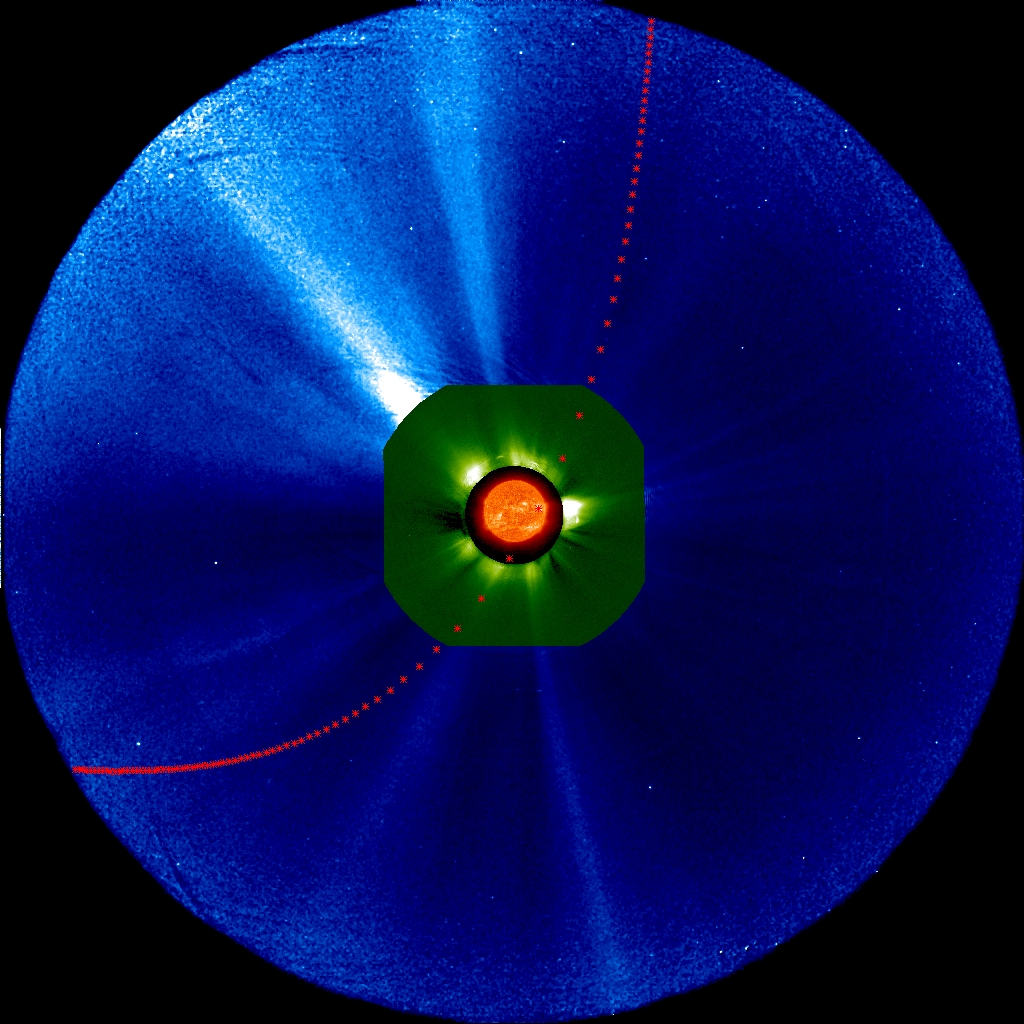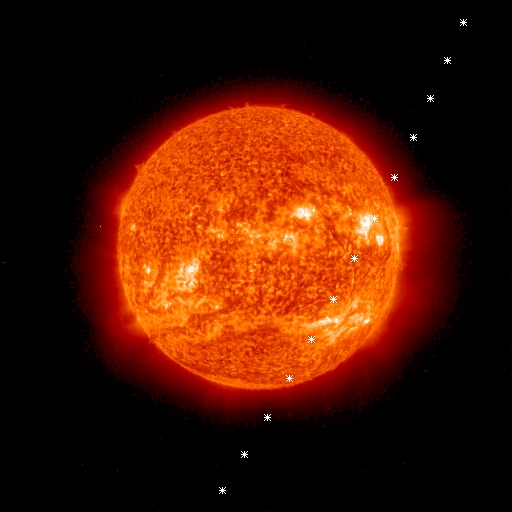Watch Comet ISON live – Solar observatories schedule

On November 28, 2013 at 18:44 UTC Comet ISON will reach its perihelion and fly by about 1.2 million km (730 000 miles) above the solar surface. Since space-based solar observatories will be recording its passage just follow the links and timetable below for front row seat.
STEREO is already taking unique images and videos. Take a look at its image of Comet Encke and ISON on November 26. The movie is in the link below.
Near-real time updates, with images and videos are here: Comet ISON vs The Sun

STEREO A HI1 image taken at 12:49 UTC on November 26, 2013 (Credit: NASA/STEREO)
Click here for video.
Solar observatories watching ISON's passage and perihelion – schedule
- Oct 10: Enters STEREO/SECCHI HI-2A (to Nov 22)
- Nov 21: Enters STEREO/SECCHI HI-1A (to Nov 28)
- Nov 26 0400: Enters STEREO/SECCHI COR-2B
- Nov 27 0200: Enters SOHO/LASCO C3
- Nov 28 0400: Enters STEREO/SECCHI COR-2A
- Nov 28 1300-2300: Transits SOHO/LASCO C2
- Nov 28 1600-2300: Transits STEREO/SECCHI COR-1B
- Nov 28 1700-2200: Transits STEREO/SECCHI COR-1A
- Nov 28 1720-1920: Transits SOHO/SUMER
- Nov 28 1810-2010: Transits STEREO/SECCHI EUVI-B
- Nov 28 1820: Transits SDO/AIA
- Nov 29 1400: Exits STEREO/SECCHI COR-2A
- Nov 29 2000: Exits STEREO/SECCI COR-2B
- Nov 30 2300: Exits SOHO/LASCO C3
- Nov 31 0000: Enters STEREO/SECCHI HI-1A (to Dec 7)
STEREO
 |
 |
 |
| Predicted hour-by-hour position of Comet ISON in the COR2-A (blue) and COR1-A (green) fields-of-view between 04:00 UTC on November 28, and 13:00 UTC on November 29. | Predicted hour-by-hour position of Comet ISON in the COR2-B (blue), COR1-B (green), and EUVI-B (orange) fields-of-view between 06:00 UTC on November 26, and 00:00 UTC on November 30. | Predicted position of Comet ISON in the EUVI-B field-of-view in ten-minute intervals between 17:50 UTC and 20:00 UTC on November 28, 2013. |
Both STEREO spacecraft will have a view of the comet in the COR1 and COR2 coronagraphs in the hours around closest approach on November 28.
The coronagraphs on STEREO Ahead will be able to see the comet for about a day and half between about 04:00 UTC on November 28, and 13:00 UTC on November 29. The Behind coronagraphs will have a longer look at the comet, from about 06:00 UTC on November 26 until the end of the day on November 29. During the period when Comet ISON is closest to the Sun, it will actually pass in front of the Sun as seen from Behind.
STEREO-A will be the only one that sees the comet transit across the face of the Sun.
Make your own ISON movies from STEREO images here.
SDO

Comet ISON – perihelion with SDO. Image credit: NASA SDO
Solar Dynamics Observatory, or SDO, will view the comet for a few hours around perihelion. SDO’s imagery should be detailed enough to gather information about how the comet evolves through the radiation and pressure of the Sun’s atmosphere.
SDO spacecraft will off-point at three different positions as Comet ISON moves through perihelion. This website will display SDO's near realtime images and movies. Images should begin appearing sometime between 17:44 and 18:00 UTC (12:45 pm and 1:00 pm ET). The Sun will appear in the upper right corner of the images and Comet ISON will move through the images from the lower right to the upper left.
SDO home page will have images from four of the AIA wavelengths during each the views (off points), Approach, Perihelion, and Departure. These wavelengths were chosen because in December 2011, when Comet Lovejoy passed perihelion, it was very bright in these wavelengths, and they believe they are the best choice for Comet ISON. We will not see a normal comet tail. The glowing material is forced to move along the Sun's magnetic field. It will look like a cloud moving along and away from the orbit of the comet.
Make videos of ISON with SDO images here.
SOHO

Comet ISON – passage and perihelion with SOHO. Image credit: NASA SOHO
From SOHO's viewpoint the comet enters from the lower right early on November 27 and exits towards the top near the end of November 30.
ISON is expected to enter the LASCO C3 field-of-view at 02:00 UTC on Wednesday, November 27, and the C2 field-of-view at 13:00 UTC on Thursday, November 28.
It is expected to leave the C2 field-of-view at 23:00 UTC on Thursday, and the C3 field-of-view at 23:00 UTC on Friday, November 29.
If you want to make videos with SOHO images, the link is here.
HINODE
The X-Ray Telescope on the JAXA/NASA Hinode mission will also be looking at Comet ISON for about 55 minutes during perihelion.
Live events
On November 28 from 18:00 – 20:30 UTC
- NASA's will host Google+ Hangout "Fire vs. Ison" for live coverage of perihelion and the comet's potential breakup.
Twitter channels with frequent updates:
- Sungrazer Comets – https://twitter.com/SungrazerComets
- Comet ISON News – https://twitter.com/CometISONnews
- Near-real time updates, with images and videos are here: Comet ISON vs The Sun
Other useful links:
- Comet ISON Observing Campaign Calendar (CIOC)
- SpaceWeather has dedicated real-time Comet ISON image gallery
- Comet ISON – Timeline of events and best images since its discovery
- 3D model of ISON's approach with view from Earth mode for ground observations
Featured image: Solar System Scope. Edit: The Watchers
CRITICALLY IMPORTANT: Comet ISON is extremely close to the Sun and you should NOT attempt to observe it in binoculars or telescope unless you are highly experienced in making these observations. Sunlight through magnifying optics can and WILL permanently damage eyesight.

it's party time…!!!